Miami Marlins Legacy Series: Best Ever Third Basemen

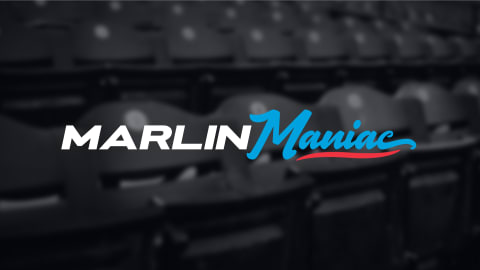
The Miami Marlins have seen 17 Opening Day starters at third base, and in total, 73 have manned the hot corner.
We’ve got 27 seasons of major league history with the Florida / Miami Marlins, under one name or another. During that time, 73 players have at one time or another held down the fort at the hottest corner in baseball, third base.
What we’ve gathered here for your reading pleasure today is the 10 most prolific third basemen to have played with the Miami Marlins. There have been a lot of players to have played multiple positions with the team, and some of them appear in this list. What we’re focusing on is the amount of games logged at the position exclusively. So even though Miguel Rojas has played third base in 79 contests, that’s not enough to make this list. The number 10 player has 154 appearances there. Who just barely missed the cut?
Dave Magadan (111 appearances)
Magadan was a seven-year veteran of the New York Mets when he signed a contract with the still-not-yet-debuted Florida Marlins in late-1992. He played half a season with the club, then got traded to the Seattle Mariners for Henry Cotto and Jeff Darwin. Seattle traded him back after the season to get Darwin back for some reason. As a Marlins player, he hit .281/.393/.358 in 140 games.
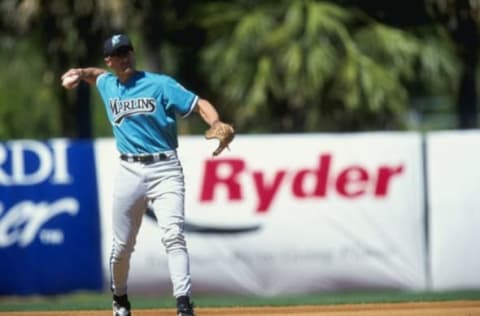
Kevin Orie (112 appearances)
Orie split his major league career between the Chicago Cubs and the Florida Marlins. In 1998 and 1999, he hit .258/.328/.407 for the team, playing mostly at third base with a little time at first.
Emilio Bonifacio (128 appearances)
Bonifacio had an 11-season major league career, spent between eight teams. By far, his biggest impact came with the Florida/Miami Marlins from 2009 through 2012.
More than any other player on this list, including super-utility stud Dietrich, Boni played all over the place, including substantial time at shortstop and center field. He hit .271/.332/.345 in 416 games in total, then joined the Toronto Blue Jays in the mammoth 12 player trade which also saw the exodus of Josh Johnson.
Greg Dobbs (136 appearances)
Dobbs’ time with the Marlins had significant overlap with Bonfacio’s last two seasons with the team. Dobbs remained through 2013. Primarily a third baseman in 2011, he split time evenly between third and the outfield in 2012 and was mostly a first baseman in 2013. He was a .264/.307/.362 hitter in 383 Marlins games.
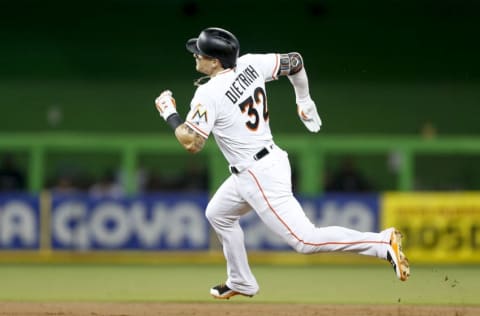
Derek Dietrich (145 appearances)
Dietrich spent each of his first six major league seasons with the Miami Marlins before being granted his free agency after the 2018 season. Now a power hitter for the Cincinnati Reds, Dietrich is known for his utility, hustle, sporadic power, and the most painful way to get to first base. He’s the Miami Marlins career leader in HBP, with 93.

10. Alex Arias (154 appearances)
Mostly a shortstop, Arias also had a seasons-worth of games at third base over his five seasons with the Florida Marlins. He hit .265/.335/.342 in 423 career games, helping them to their first World Series Championship, in 1997.
Born in New York City on November 20th, 1967, Arias was a third round choice of the Chicago Cubs in 1987. The Florida Marlins acquired him after his 1992 major league with the Cubs, along with Gary Scott for Greg Hibbard. Arias hit .293 in 32 contests for Chicago.
In his first season with the nascent Florida Marlins, Arias played at least 118 innings at second, third and shortstop, grading out as below average defensively at each. Granted, his 161 1/3 innings at the hot corner resulted in a just-below average mark of minus-1 fielding runs per 1200 innings. Sweetening the pot was his .344 OBP and solid patience at the plate, which resulted in 27 walks versus only 18 strikeouts.
Arias continued his position-splitting ways in the strike-shortened 1994 season. He only appeared in 59 games, mostly as a pinch hitter but also at shortstop and third base. Despite just over 200 total innings in the field, he graded out near-average defensively, but suffered to a .239 batting average.
1995 would see Arias’ average recover to a more-palatable mark of .269 over 94 appearances. In 21 games at third base, including a dozen starts, he fielded a dismal .939 while ranking just above the NL average at the position.
In 1996, Arias played in a career-high 59 games at third base while fielding .956 and grading out 10 runs better than-average per-1200 innings at the position, or about one defensive win. A then-career-best .277 batting average was just frosting.
Arias ended up playing 154 games at third base for the Miami Marlins, ranking 10th on their all-time leaderboard.
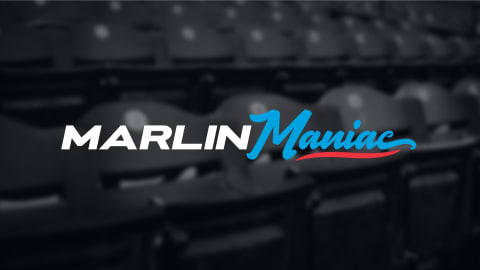
9. Brian Anderson (163 appearances)
The Miami Marlins would-be current third baseman, Anderson has shown an ability to throw out runners from right field as well. No good deed goes unpunished.
Still though, Anderson has amassed 163 games at third base, just over a full seasons’ worth of data. The picture that data paints is clear – Anderson is only getting better.
Currently at 3.8 Wins Above Replacement, Anderson leads the 2019 Miami Marlins in the category. Born in Edmond, Oklahoma on May 19th, 1993, Anderson is under team control through the 2024 season. They lucked out by choosing him in the third round of the 2014 draft out of the University of Arkansas.
After hitting 11 homers last season along with a .273 average, Anderson finished fourth in the National League Rookie of the Year vote. He’s outdone himself on the offensive side of the plate in 2019, hitting 20 homers with about 40 games remaining in the season. His emergent power stroke has driven his slugging average from .400 last season to .470 this year.
Using the defensive runs saved per 1200-innings metric, we see that Anderson turned in a mark of minus-27 in a 200-inning look in 2017. In 2018, he was 15-runs below average in right field and 10-below at third in 2018.
This season, Anderson has played at least 446 innings at each of the two positions, and is seven-runs better than average at third while turning in a mark of plus-13 in right field. He also improved his fielding average at the hot corner by 35 points, from .942 to .977 between the two seasons.
I don’t think Anderson is done improving. The Miami Marlins need to build around someone, and I can think of few better choices than their two-position stud.
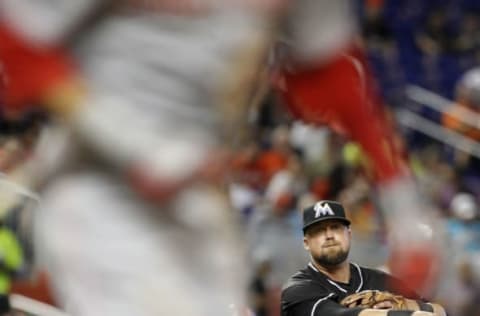
8. Casey McGehee (168 appearances)
McGehee was born on October 12th, 1982 in Santa Cruz, California. Another Cubs draft choice, they took him in the 10th round of the 2003 event.
McGehee made his major league debut with the Cubs in 2008, going four-for-24 in a short look. By the time he got back again, the following season, he was a member of the Milwaukee Brewers. After three seasons mostly in their starting lineup, he split the 2012 season between the Pittsburgh Pirates and the New York Yankees.
McGehee played the 2013 season in the Japan Pacific League with the Tohoku Rakuten Golden Eagles. He hit 28 homers in 144 games, slashing .292/.376/.515. the Miami Marlins signed him through free agency for the 2014 campaign.
In 2014, McGehee led the Marlins with 160 games played, including 158 starts at third base. Although his power didn’t come with him from Japan (only four homers all season), he did hit a team-second .287 (one point behind Giancarlo Stanton‘s mark of .288). Defensively, he turned in a .979 fielding percentage and graded out just barely below average, at minus-three runs.
After the season, the Miami Marlins traded McGehee to the San Francisco Giants for Luis Castillo (yes, that Luis Castillo) and Kendrys Flores. After they waived him in July, the Marlins resigned him for the rest of the 2015 season. He appeared in 60 games for Miami, and played in 10 more games at the hot corner. In total, McGehee played 168 games at third base.
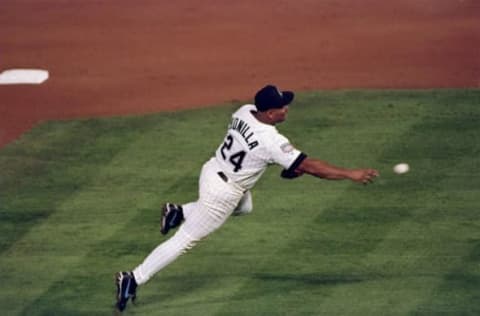
7. Bobby Bonilla (175 appearances)
Bonilla, another third baseman out of New York City (the Bronx, technically), was born on February 23rd, 1963. After going undrafted, he joined the Pittsburgh Pirates minor league system, and eventually made his major league debut with the Chicago White Sox in 1986 after a rule 5 gamble.
The Pirates weren’t happy to part with Bonilla, and sent Jose DeLeon to the White Sox prior to the trade deadline to get him back. So Bonilla played 138 games in his first big league season, split near-even between the two leagues. He would remain with the Pirates through the 1991 season, making four all-star teams during that time.
After three and a half seasons with the New York Mets and a year-and-a-half with the Baltimore Orioles (and another two all-star game invitations), Bonilla signed with the Florida Marlins through free agency prior to the 1997 campaign.
You’ll remember that in that season, then-owner H. Wayne Huizenga went all-in during free agency, and wound up with the then Florida-Marlins winning their first World Series Championship after only five years as a team. Bonilla hit .297/.378/.468 in 153 games, with 17 homers and 96 RBI. Defensively, he played 1268 2/3 innings at third base, racking up a .938 fielding percentage with a minus-13 Rtot/yr.
Bonilla appeared in 28 games for the 1998 Florida Marlins before Huizenga traded him with Manuel Barrios, Jim Eisenreich, Charles Johnson, and Gary Sheffield to the Los Angeles Dodgers for Mike Piazza and Todd Zeile.
Bonilla has retained a small slice of the national spotlight due to his famously getting paid $1 million per year in deferred payments from the Mets after they bought out his 2000 season. From 2011 through 2035, Bonilla will continue to collect. He will be 72-years-old when he receives his final paycheck.

6. Terry Pendleton (237 appearances)
Pendleton was born in Los Angeles, California on July 16th, 1960, and initially chosen in the seventh round of the 1982 MLB Amateur Entry draft by the St. Louis Cardinals.
He made his major league debut with them just one year later, and remained a Cardinal through his first seven big-league seasons. He won two Gold Gloves at third base while playing there.
Pendleton then spent his next four seasons with the Atlanta Braves, winning the NL MVP in 1991 and making his first and only all-star appearance in 1992. He signed with the Florida Marlins through free agency for the 1995 season.
Although already 34-years-old by the time he joined the Florida Marlins, Pendleton performed well for the team, racking up a 1.9 WAR during his first season. Defensively, he rated an Rtot/yr of two runs, just a hair above “average.” At the plate, he hit .290/.339/.439 with 14 homers and 78 RBI.
Pendleton remained with the Marlins for the Lion’s Share of the 1996 season, playing in 111 games to include 108 at third base. A .961 fielding percentage and a .251/.298/.357 slashline made him expendable at the deadline, and the Marlins sent him back to Atlanta for Roosevelt Brown.
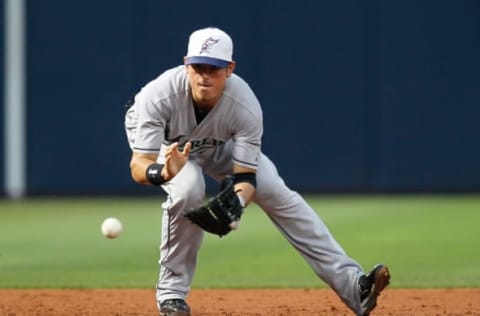
5. Jorge Cantu (255 appearances)
Jorge Cantu was born on January 30th, 1982 in McAllen, Texas. After going undrafted in 1998, the Tampa Bay Rays signed him through free agency and sent him to their short-season-A NYPL outfit, the Hudson Valley Renegades.
It took Cantu until 2004 to break the major league barrier with Tampa Bay, and he played mostly second base for them during his three-plus big league seasons there. At the 2007 trade deadline, he joined the Cincinnati Reds in a four-player deal, then was released after the season closed.
It didn’t take long for the Florida Marlins to ink Cantu to a deal. The 2008 season opened with Cantu as the Marlins starting third baseman, and he went on to appear in 129 games at the position, and 155 overall through the campaign.
Cantu had hit 28 homers in 2005, but that power seemed to have gone missing afterwards. It came back with a vengeance for the Marlins, to the tune of a 29 homer season. Cantu hit .277/.327/.481 with 95 RBI on the offensive side of the plate. As a third baseman, he turned in a below-average .937 fielding percentage, and was worth minus-two runs over his season – just barely below “average.”
2009 would see Cantu’s power stroke cut back to only 16 round-trippers, but he ranked second on the team with 100 RBI while slashing .289/.345/.443. Defensively, the Marlins had Cantu play in 111 games at first base versus 45 at the hotter corner. His resultant .910 fielding percentage and minus-10 Rtot/yr bore that out.
Cantu played in another 81 games at third base for the Marlins in 2010, but his fielding percentage languished at .909 over 632 1/3 innings. Although he slashed .262/.310/.409 for the Fish, he also turned in a -1.0 WAR, the only time in his three Marlins season he was below zero. At the trade deadline, Florida sent him to the Texas Rangers for Omar Poveda and Evan Reed.
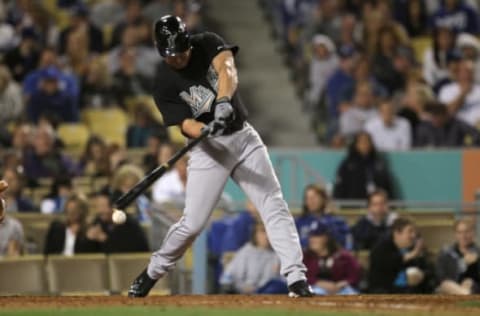
4. Wes Helms (277 appearances)
Despite his position at number four on this list, Wes Helms was the definition of a “replacement level” player. 13 major league seasons would see him complete his career with a WAR of minus-1.7. In fact, he didn’t finish with a positive WAR for any of the four franchises he spent time with.
The biggest cut of Helms’ career was spent with the Florida Marlins. After getting picked in the 10th round of the 1994 MLB Amateur Entry Draft by the Atlanta Braves, Helms made it to the majors with the franchise in 1998 for the first time. He played four years for the Braves, then spent three seasons with the Milwaukee Brewers.
Granted free agency following the 2005 season, Helms signed on with the Florida Marlins. Speaking back to Helms’ WAR figure, 2006 was his best major league season, by far. In fact, his one-year WAR output of positive-1.7 matched his overall negative figure through his whole career. In 140 games for the Marlins, he hit .329/.390/.575 with 10 homers and 47 RBI. Mostly a first baseman for the season, he also played in 24 contests at third base.
Despite his solid showing, the Marlins granted free agency to Helms, who went on to play the 2007 season with the Philadelphia Phillies before returning to Florida in 2008.
In 132 games for the Marlins that season, Helms hit .243/.299/.347 with only five homers and 31 RBI. Defensively, he was a rock star at third, with a .989 fielding percentage in 325 innings of work and 12 runs saved above the “average” third baseman. Collectively, however, Helms was worth -0.1 WAR.
In 2009, Helms fielding percentage at third base regressed to a figure of .935, although he finished the year 15 runs better than average. He also hit .271 in 113 games.
Helms productivity took a sharp turn to the south in 2010, which saw him hit just .220 in 127 games. His negative-0.9 WAR was the second worst mark of his career, and despite a solid .952 fielding percentage at third base, he was 16-runs-below average in Rtot/yr.
Despite a 13-season career, Helms only once collected enough plate appearances to qualify for the League leaderboard, in 2003 with the Brewers, when he had 536. He never had more than 287 with the Marlins, and that was in his 2010 season. Even so, the guy spent 13 seasons in the majors, and that’s really something, isn’t it?
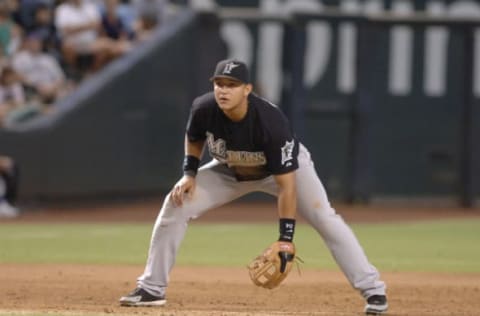
3. Miguel Cabrera (373 appearances)
Without a doubt a first-ballot Hall of Famer, Cabrera started his professional carer after signing with the Florida Marlins in 1999. Only 17-years-old at the time, it took a $1.9 million bonus to get Miggy on the dotted line.
Born on April 18th, 1983, Cabrera is a native of Maracay, Venezuela. He made relatively quick work of the Florida Marlins minor league feeder affiliate system, graduating to the majors in 2003 while still just 20. He appeared in 87 games as a rookie, and hit .268 with 12 dingers and 62 RBI. His .793 OPS was his lowest figure, by far, until 2017. Although mostly a left-fielder at that time, Cabrera also started 30 games at third base, and fielded at a solid .986 clip. In the NLCS, Cabrera was 10-for-30 with three homers, and eventually helped the Marlins to their second World Series Championship.
2004 would see Cabrera blossom into a well-above-average major leaguer. He slashed a .294/.366/.512 line with 33 homers and 112 RBI, although he did not appear at third base at all. For his efforts, he earned his first all-star nod.
In 2005, Cabrera kept his prodigious power stroke while boosting his average 30 points. He slashed .323/.385/.561 with 33 round-trippers and 116 RBI. Again mostly a left-fielder, he also made 28 starts at third base, fielding at .971 and again making the all star team while earning his first Silver Slugger award. His 5.2 WAR was the ninth-best in the major leagues.
Cabrera took over third base completely in 2006, starting 157 games at the hot corner and fielding at .957 over 1334 innings of work. He made his third all-star team and got his second Silver Slugger, while finishing fifth in the National League MVP vote for the second year in a row. No slouch with the bat, Cabrera raked to a .339/.430/.568 clip with 26 home runs and 114 RBI. He finished the year with a 5.8 WAR, good enough for eighth in the majors.
It was more of the same in what would be Cabrera’s final season with the Florida Marlins, in 2007. Thirty-four home runs, 119 RBI, a .320/.401/.565 slashline, and another all-star invitation. Cabrera played 152 games at third base that year, including 134 starts and finishing with a .941 fielding percentage.
Of course, the rest is history that we’re all familiar with. After the 2007 season, Cabrera was sent with Dontrelle Willis to the Detroit Tigers for Dallas Trahern, Andrew Miller, Mike Rabelo, Burke Badenhop, Cameron Maybin, and Frankie de la Cruz. He’s since gotten into six more all-star games and was named the American League MVP in 2012 and in 2013. With 2,791 career hits under his belt, Cabrera is a good bet to join the 3,000 club, and has five years remaining on his current contract.
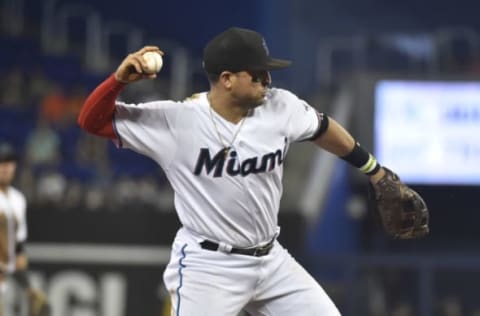
2. Martin Prado (376 appearances)
Like Cabrera, Prado was also born in Maracay, Venezuela. Signed by the Atlanta Braves through international free agency in 2001, he made his major league debut with them in 2006.
Prado remained with the Braves through the 2012 campaign, earning an all-star invitation in 2010 when he hit .307/.350/.459 with a career best 15 home runs. He then spent a year-and-a-half with the Arizona Diamondbacks and the 2014 stretch-run as a New York Yankee.
After the 2014 season, Prado was traded to the Miami Marlins with David Phelps and cash for Nathan Eovaldi, Domingo German, and Garrett Jones. For more on how we won that trade, big time, check here.
Prado’s first season in Miami would see him slash out a .288/.338/.394 line in 129 games. He played in 124 of those at third base, including 118 starts. He also appeared 11 times at second. As a third baseman, he fielded at a .976 percentage, 21 points better than the NL average at the position. He was eight runs better than average for the season, prorated to 1200 innings.
In 2016, Prado played a career high 1264 2/3 innings at the hot corner, fielding at .972 and finishing with a Rtot/yr of zero – or dead average. His most prolific showing with the Miami Marlins by far, Prado hit .305/.359/.417.
2017 would begin a two-season slog for Prado, who dealt with injuries and spent more time on the injured list than on the active roster. He totaled 91 games for those two years, hitting .246/.284/.326. When healthy, he was again right near the middle in terms of defensive worth – coming in at one run under average per 1200 innings. He fielded at .980 over that time.
This year, Prado has spent more time at first base than third, but still shows average to better-than-average defense when placed there. Still, he’s hitting only .242/.268/.298, and is undoubtedly coming to the end of his major league career. The Miami Marlins would do well to retain Prado in a coaching or managing capacity when he does decide to hang up his cleats.
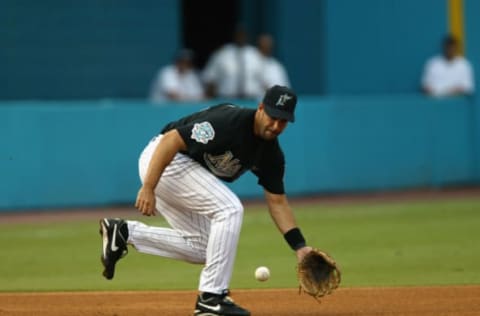
- Mike Lowell (939 appearances)
Mike Lowell was born on February 24th, 1974 in San Juan, Puerto Rico. Back in 1992, he was drafted in the 48th round by the Chicago White Sox, then again in 1995 in the 20th round by the New York Yankees. He made his major league debut with them three years later, going four-for-15 in eight games. After the season, they traded him to the Florida Marlins for Todd Noel, Mark Johnson, and Ed Yarnall.
Lowell, who is a testicular cancer survivor, is far and away the most prolific Florida / Miami Marlins third baseman. He has played in a franchise-fourth 981 games for the Marlins. While in the field, the only other positions he played were designated hitter, for those occasional inter-league games, and second base, eight times in 2005. During his seven seasons with the Marlins, he made the all-star team three times and won a Gold Glove at third in 2005. He slashed .272/.339/.462 during his tenure with the club, hitting a franchise-fourth 143 round-trippers and collecting a franchise second-best 578 RBI, second only to Stanton’s 672. He also won his only Silver Slugger Award in 2003, when he hit 32 homers with 105 RBI while slugging a career-best .530.
More from Marlins History
- Miami Marlins One-Year Wonder 1B
- Miami Marlins players & the 2023 Hall of Fame
- Former Miami Marlins star is retiring
- Gary Sheffield or Mark Buehrle, will either Marlin make the Hall of Fame?
- Why don’t we see more dynasties? Part 3
Lowell remained in shouting distance of the N.L. “average” third basemen in most of his seasons with the Marlins. The exception was his Gold Glove campaign, where he fielded at .983 and made only six errors in 1126 2/3 innings. He was worth 13 Rtot/yr, and closed his career with an overall third base fielding mark of .974, which was 18 points above the average mark for that time period.
Lowell went on to join the Boston Red Sox after the 2005 season, with Josh Beckett and Guillermo Mota for Jesus Delgado, Harvey Garcia, Hanley Ramirez, and Anibal Sanchez. That was one of those rare trades where both teams won.
For Lowell’s part, he went on to make the all star team one more time, in 2007, and made his last major league appearance in 2010.
Thanks for reading. Follow us on Twitter, like us on Facebook, and subscribe to our daily newsletter to keep up with the Miami Marlins.
Next. Third Most Hopeless? What?. dark